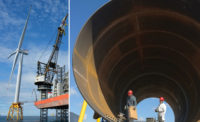Large spending increases in renewable energy, as well as on carbon capture and storage, will be necessary to generate hydrogen needed later this century, according to Norway-based consultant DNV in its new Hydrogen Forecast 2050.
Hydrogen will account for 0.5% of the global energy mix by 2030, rising to 5% mid century, says the firm's report. To meet greenhouse gas reduction targets set in the Paris Agreement, hydrogen production would need to reach 15% by 2050, it adds.
Environmentally cleaner green hydrogen, powered by renewable energy, will account for 72% of global output by 2050, forecasts DNV. This will require 3,100 GW of surplus renewable capacity, which “is more than twice the total installed generation capacity of solar and wind today," it notes.
Blue hydrogen, which is produced from natural gas with emissions captured, will account for 30% of total production in 2030. “But its competitiveness will reduce as renewable energy capacity increases and prices drop,” DNV contends.
Global spending on hydrogen production for energy purposes will total $6.8 trillion by 2050, with another $180 billion invested in pipelines. More than 50% of global hydrogen pipelines will be repurposed from natural gas distribution.
“Policies do not match hydrogen’s importance,” sayss Remi Eriksen, DNV president and CEO. “They will … need to support the scaling of renewable energy generation and carbon capture and storage as crucial elements in producing low-carbon hydrogen.”






Post a comment to this article
Report Abusive Comment